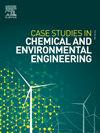Unveiling microfiber emissions: A comprehensive analysis of household washing activities and mitigation measures
Q1 Environmental Science
Case Studies in Chemical and Environmental Engineering
Pub Date : 2024-12-18
DOI:10.1016/j.cscee.2024.101070
引用次数: 0
Abstract
The shedding of microfibers from synthetic textiles during laundry significantly contributes to microplastic pollution in various environments. Despite growing awareness, the contribution of microfiber emissions from actual household washing machines and the potential influences of washing activities on their release remain inadequately understood. This study aims to quantify and characterize microfibers generated from different washing programs in actual household washing activities. It proposes optimal conditions for washing machine activities to effectively mitigate the environmental consequences of microfiber contamination using Response Surface Methodology (RSM). The results indicated that types of washing machines, speed of configuration and cycle duration significantly impact on microfiber release quantities. The estimated microfiber releases for the daily, quick, and delicate programs from the front-loading machine were 62.82 ± 6.29 mg/kg, 48.56 ± 15.85 mg/kg, and 12.73 ± 3.04 mg/kg, while the top-loading machine exhibited microfiber release levels of approximately 69.26 ± 3.44 mg/kg, 38.35 ± 5.54 mg/kg and 7.50 ± 2.51 mg/kg, as washing load of 4.21 kg, respectively. Polyester was identified as the predominant polymer, with an average fiber length of 1915 μm. The dominant colors of the fragments are white, dark blue, and red, which are related to the original household textiles test. The optimal conditions for reducing microfiber emissions include using a rotational speed of 1450 rpm and a cycle duration of 1.7 hours, alongside selecting appropriate washing programs with optimal durations to minimize releases during household laundry.

揭露超细纤维排放:家庭洗涤活动和减缓措施的综合分析
在洗衣过程中,合成纺织品上的微纤维脱落对各种环境中的微塑料污染起着重要作用。尽管越来越多的人意识到,实际家用洗衣机排放的超细纤维的贡献以及洗涤活动对其释放的潜在影响仍然没有得到充分的了解。本研究旨在量化和表征在实际家庭洗涤活动中不同洗涤程序产生的微纤维。它提出了洗衣机活动的最佳条件,以有效地减轻超细纤维污染的环境后果使用响应面法(RSM)。结果表明,洗衣机类型、配置速度和循环时间对超细纤维释放量有显著影响。预估的每日、快速和精细程序的微纤维释放量分别为62.82±6.29 mg/kg、48.56±15.85 mg/kg和12.73±3.04 mg/kg,而顶部加载机器的微纤维释放量分别约为69.26±3.44 mg/kg、38.35±5.54 mg/kg和7.50±2.51 mg/kg,洗涤负荷为4.21 kg。涤纶为主要聚合物,纤维平均长度为1915 μm。碎片的主色调为白色、深蓝色、红色,与原来的家用纺织品测试有关。减少超细纤维排放的最佳条件包括使用1450转/分钟的转速和1.7小时的循环时间,同时选择合适的洗涤程序,以最大限度地减少家庭洗衣时的释放。
本文章由计算机程序翻译,如有差异,请以英文原文为准。
求助全文
约1分钟内获得全文
求助全文
来源期刊

Case Studies in Chemical and Environmental Engineering
Engineering-Engineering (miscellaneous)
CiteScore
9.20
自引率
0.00%
发文量
103
审稿时长
40 days
 求助内容:
求助内容: 应助结果提醒方式:
应助结果提醒方式:


